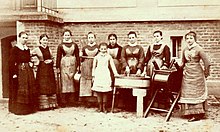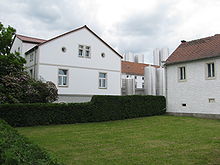Heinrichsthaler Milchwerke
| Heinrichsthaler Milchwerke GmbH
|
|
|---|---|
| legal form | GmbH |
| founding | July 1, 1880 |
| Seat |
Radeberg , Germany |
| management | Uwe Lammeck (Managing Director) |
| Number of employees | 242 |
| sales | 215.4 million euros |
| Branch | dairy |
| Website | www.heinrichsthaler.com |
| As of September 30, 2014 | |
The Heinrich Milchwerke are a dairy in Radeberg , Saxony . The dairy in Heinrichsthal , founded in 1880, produced the first German Camembert in 1884 . Today the dairy is a medium-sized company with an annual turnover of more than 100 million euros and over 200 employees.
The historic buildings at Großröhrsdorfer Straße 15 are now a listed building .
Location
Since it was founded, the only location of the dairy has been the former Vorwerk Heinrichsthal. It is located in the town of the same name in the large district town of Radeberg in the Bautzen district , about twelve kilometers northeast of the city center of the state capital Dresden . The estate on Großröhrsdorfer Straße is almost completely built over by the production facilities. The even larger Sachsenmilch AG plant in Leppersdorf is located just four kilometers to the northeast . Until 1998, the Heinrichsthaler Milchwerke maintained another production facility in Burkau .
history
Agathe Zeis , the wife of the Heinrichsthal landowner Hermann Alexander Zeis, founded the housekeeping school and teaching dairy in Heinrichsthal on July 1, 1880. Four years after it was founded, the company acquired the patent for Camembert and Brie and became the first manufacturer of these French soft cheese specialties in Germany. On November 26, 1883, the dairy received the title of Royal Saxon Court Supplier , and a year later it also supplied the Grand Duke of Hesse . In 1886 the German Dairy Association awarded her its gold medal.
After the death of Agathe Zeis in 1887 and the bankruptcy of her husband a year later, Heinrich and Louis Prinz took over the teaching and French cheese dairy Heinrichsthal and kept it in their possession until March 1904. They appointed Albert Lincke as authorized signatory. From June 16, 1888, the dairy operated as "Meierei Heinrichsthal HEL Prinz", from June 1893 as "Meierei Heinrichsthal Prinz & Lincke". In that year, the company again became a supplier to the Royal Saxon Court under its new owners. That is why it advertises today with the slogan “Royal cheese specialties”.
The company has been exporting its products worldwide since the beginning of the 20th century. As early as 1904 it developed a sterilization process that enabled Camembert to be shipped overseas in a tropicalized condition. Since the First World War , the company has been producing long-lasting camembert in tin cans to supply the German troops. This procedure later prevailed throughout Germany. After 1910, Heinrichsthaler Meierei set up a sales office in New York. She owned patents on whey utilization, the production of penicillin based on lactose and diet cheese, and the manufacture of medicinal products from whey . In 1930, 50 years after it was founded, the company had 68 employees and processed 4.5 million liters of milk into soft cheese. It remained in private ownership until it was expropriated at the end of World War II .
In 1945 the dairy was rebuilt. Two years later it was transferred to the Radeberg dairy cooperative of the VdgB . The dairy engineer from an East Prussian dairy family and long-time manager of the Großenhainer dairy cooperative Winrich Lammeck took over the management of the Heinrichsthaler dairy operation in 1962. From 1970 to 1972, extensive renovations and new buildings took place on the site. The Radeberger dairy cooperative was the largest producer of soft, semi-hard and hard cheese in the GDR . According to its own information, Heinrichsthaler Milchwerke still had a market share of around 40 percent in eastern Germany until 1996.
After the reunification , the company initially fell into a crisis. In 1991 Gebr. März AG from Rosenheim got on board and in 1992 converted the dairy into Heinrichsthaler Milchwerke GmbH. Shortly before Gebr. März AG got into financial difficulties in 1995 and finally went bankrupt, the Radeberger Dairy Cooperative bought back its shares in the company. The cooperative consists of 40 shareholders and is still the sole shareholder of the company. During the two decades after the fall of the Wall, Heinrichsthaler Milchwerke GmbH invested over 35 million euros in expanding its production facilities. The construction of a new logistics center with a new salt bath and space for 4,000 cheese pallets, which the Saxon Environment Minister Frank Kupfer opened on June 19, 2010, cost around ten million euros alone .
Products
The main brand of the dairy is the Heinrichsthaler , a cheese available in numerous varieties. Around 70 percent of the total production of grated and sliced cheese is intended for large consumers such as catering companies, and around 30 percent goes to food retailers. The Heinrichsthaler Milchwerke also supply chains such as Aldi, Rewe, Edeka, Kaufland and Netto with cheese for their own brands. In 2004 the company received the IFS seal of approval for its products.
The dairy specializes in the production and processing of hard and semi-hard cheese. In addition to cheese slices and portions, it also offers grated cheese in various packaging sizes. In addition to the common types of Edam, Gouda, Tilsiter, Butterkäse, Emmentaler and Maasdamer, the Heinrichsthaler Milchwerke also have various specialties on offer, including wild garlic cheese, fenugreek cheese and Elbländer. The company also produces Radeberger beer cheese and the "cheese feet", sliced cheese in the shape of a foot for children. It has been producing lactose-free cheese since 2006, which is suitable for people with lactose intolerance .
The soft cheese, for which the dairy was known in the late 19th century and in the GDR era, is produced by the Ebert company in Falkenhain near Leipzig on a contract basis according to the original recipe. It is currently not manufactured in Heinrichsthal itself. Around 2012, a show dairy is to be built in the historic company building, in which the Camembert will be produced again.
Facts
- Every year 70 farms from the districts of Bautzen and Meißen deliver around 125 million kilograms of milk to Heinrichsthaler Milchwerke.
- For a Heinrichsthaler daily production around 25,000 cows have to be milked.
- The Heinrichsthaler Milchwerke produce around 25,000 tons of cheese every year.
- The number of employees is 200. In 1997 there were 92 employees.
- Between 2004 and 2008, sales almost doubled from 73 million euros to 140 million euros.
- The export share of the company's production in 2010 was around 70 percent.
Web links
Individual evidence
- ↑ Imprint
- ↑ a b Federal Gazette : Annual financial statements for the financial year from October 1, 2013 to September 30, 2014
- ↑ Landwirtschaft.sachsen.de ( Memento of the original from August 3, 2014 in the Internet Archive ) Info: The archive link was automatically inserted and not yet checked. Please check the original and archive link according to the instructions and then remove this notice.
- ↑ Architectural cultural monuments of the core town of Radeberg. (PDF; 113 kB) Radeberg City Administration, June 14, 2007, p. 12 , accessed on November 14, 2013 .
- ↑ Verein-milch-und-kultur.de ( Memento of the original from March 8, 2016 in the Internet Archive ) Info: The archive link was inserted automatically and has not yet been checked. Please check the original and archive link according to the instructions and then remove this notice.
- ↑ Werner Peters: Heinrichsthaler cheese also for the king , in: Dresdner Latest News , May 25, 2004.
- ↑ heinrichsthaler.com ( page no longer available , search in web archives ) Info: The link was automatically marked as defective. Please check the link according to the instructions and then remove this notice.
- ^ Sven Eichstädt: "Royal Camembert" for all of Europe , in: Oschatzer Allgemeine Zeitung , March 23, 2000.
- ^ Ernst W. Raymund: Cradle of the German Camembert and Brie , in: Dresdner Latest News , June 23, 2000.
- ↑ Ernst W. Raymund: Heinrichsthaler earn hard euros with soft cheese , in: Dresdner Latest News , September 27, 2004.
- ↑ Dresdner Heide, Pillnitz, Radeberger Land (= values of our homeland . Volume 27). 1st edition. Akademie Verlag, Berlin 1976.
- ↑ sz-online.de ( page no longer available , search in web archives ) Info: The link was automatically marked as defective. Please check the link according to the instructions and then remove this notice.
- ^ Friedrich W. Bartel: Again Camembert from Heinrichsthaler Milchwerke , in: Dresdner Latest News , October 15, 1997.
- ↑ topagrar.com
- ↑ rbb-beteiligungen.de ( Memento of the original from May 9, 2005 in the Internet Archive ) Info: The archive link was automatically inserted and not yet checked. Please check the original and archive link according to the instructions and then remove this notice. (PDF; 51 kB)
- ↑ heinrichsthaler.com ( page no longer available , search in web archives ) Info: The link was automatically marked as defective. Please check the link according to the instructions and then remove this notice.
- ^ Ernst W. Raymund: Radeberger cheese also tastes good abroad , in Dresdner Latest News , August 11, 2005.
- ↑ sz-online.de
- ↑ a b Sächsische Zeitung from 28./29. September 2013.
- ↑ Hannelore Schuster: Cheese from Radeberg eight times awarded , in: Dresdner Latest News , August 14, 1997.
- ↑ freiepresse.de ( Memento from December 21, 2010 in the Internet Archive )





